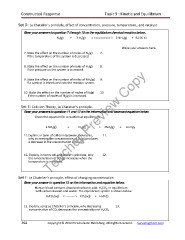Page 408 - Teacher Preview Copy
P. 408
Constructed Response . Topic 9 : Kinetic and Equilibrium
Set D: Le Chatelier’s principle, effect of concentration, pressure, temperature,, and catalyst
Base your answers to question 7 through 10 on the equilibrium chemical reaction below.
N2(g) + 3 H2(g) < ========== > 2 NH3(g) + 92.05 KJ
Write your answers here.
7. State the effect on the number of moles of N2(g) 7.
if the temperature of the system is decreased.
8. State the effect on the number of moles of H2(g) 8.
if the pressure on the system is increased.
Teacher Preview Copy
9. State the effect on the number of moles of NH3(g) 9.
if a catalyst is introduced into the reaction system.
10. State the effect on the number of moles of N2(g) 10.
if the number of moles of H2(g) is increased.
Set E: Collision Theory, Le Chatelier’s principle.
Base your answers to question 11 and 12 on the information and balanced equation below.
Given the equation for a reaction at equilibrium.
Teacher Preview Copy
2 SO2(g) + O2 (g) < ------- > 2SO3(g) + energy
11.Explain, in term of collision between molecules, 11.
why increasing the concentration of O2(g) produces
a decrease in the concentration of SO2(g).
12. Explain, in terms of Le Chatelier’s principle, why 12.
the concentration of SO2(g) increases when the
temperature is increased.
Set F: Le Chatelier’s principle, effect of changing concentration
Base your answer to question 13 on the information and equation below.
Human blood contains dissolved carbonic acid, H2CO3, in equilibrium
with carbon dioxide and water. The equilibrium system is shown below.
H2CO3(aq) < --------- > CO2(aq) + H2O (l)
13. Explain, usi ng Le Chatelier’s principle, why decreasing 13.
concentration of CO2 decreases the concentration of H2CO3.
398 Copyright © 2010 E3 Scholastic Publishing. All Rights Reserved. Survivingchem.com
Set D: Le Chatelier’s principle, effect of concentration, pressure, temperature,, and catalyst
Base your answers to question 7 through 10 on the equilibrium chemical reaction below.
N2(g) + 3 H2(g) < ========== > 2 NH3(g) + 92.05 KJ
Write your answers here.
7. State the effect on the number of moles of N2(g) 7.
if the temperature of the system is decreased.
8. State the effect on the number of moles of H2(g) 8.
if the pressure on the system is increased.
Teacher Preview Copy
9. State the effect on the number of moles of NH3(g) 9.
if a catalyst is introduced into the reaction system.
10. State the effect on the number of moles of N2(g) 10.
if the number of moles of H2(g) is increased.
Set E: Collision Theory, Le Chatelier’s principle.
Base your answers to question 11 and 12 on the information and balanced equation below.
Given the equation for a reaction at equilibrium.
Teacher Preview Copy
2 SO2(g) + O2 (g) < ------- > 2SO3(g) + energy
11.Explain, in term of collision between molecules, 11.
why increasing the concentration of O2(g) produces
a decrease in the concentration of SO2(g).
12. Explain, in terms of Le Chatelier’s principle, why 12.
the concentration of SO2(g) increases when the
temperature is increased.
Set F: Le Chatelier’s principle, effect of changing concentration
Base your answer to question 13 on the information and equation below.
Human blood contains dissolved carbonic acid, H2CO3, in equilibrium
with carbon dioxide and water. The equilibrium system is shown below.
H2CO3(aq) < --------- > CO2(aq) + H2O (l)
13. Explain, usi ng Le Chatelier’s principle, why decreasing 13.
concentration of CO2 decreases the concentration of H2CO3.
398 Copyright © 2010 E3 Scholastic Publishing. All Rights Reserved. Survivingchem.com


